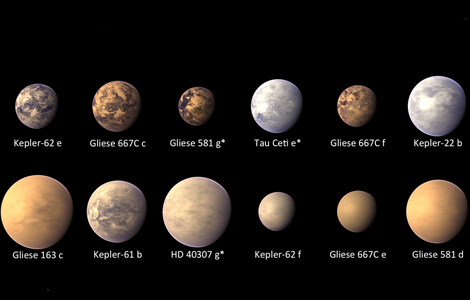The Top 12 Habitable Exoplanets
Researchers at the University of Puerto Rico are keeping a list
According to the Exoplanet Catalog maintained by the Planetary Habitability Laboratory (PHL) of the University of Puerto Rico at Arecibo, the number of confirmed planets outside our own solar system is approaching 1,000, while another 3,500 exoplanets—most of them detected by NASA’s Kepler mission—are yet to be confirmed. We’re not talking only about Jupiter- or Neptune-like gas giants, but also Super-Earths (terrestrial planets several times the mass of Earth) and Earth-size planets.
From this growing list, the PHL, directed by Abel Méndez, has identified the top 12 potentially habitable exoplanets based on an Earth Similarity Index (ESI). Their top choice is Kepler 62e, with an ESI value of 0.83 (an ESI of 1.0 would be a 100 % match with Earth in terms of astronomical parameters). Kepler 62e is a Super-Earth in the Constellation Lyra, with an estimated mass of 3.6 Earth masses and an estimated radius 1.6 times that of Earth. Its surface temperature is estimated at 31oC (88oF) and it is 7 billion years old, significantly older than Earth. It’s also very far away—1,200 light years, meaning that we won’t be visiting it any time soon.
How much like our own world is Kepler 62e, really? We should be careful to distinguish Earth similarity from planetary habitability. In many respects the Moon has very similar astronomical values to Earth, yet we know it’s a dead rock. On the other hand there’s Saturn’s moon Titan, a top candidate for finding primitive extraterrestrial life in our solar system. But Titan couldn’t be more different from Earth—an icy moon with liquid methane/ethane lakes on its surface, a nitrogen-methane atmosphere, and temperatures well below Earth’s arctic regions.
My own favorite candidate for a habitable exoplanet is Gliese 581d. A mere 20 light years from us, it’s #12 on the PHL list. The planet has an estimated mass of about seven Earth masses, with a radius about double Earth’s. Gliese 581d orbits a red dwarf star with an orbital period of 67 days, which is important. Why? A red dwarf has less energy output than our (yellow dwarf) sun, and an orbital period of 67 days would put the planet in a Mars-like orbit in terms of temperature. In our own solar system, Mars is cold and dry today because it was too small to retain a thick atmosphere, internal heating, and a magnetic field. However, if Mars had been a Super-Earth like Gliese 581d, it would surely still be heated from inside, have kept its magnetic field and thick atmosphere, and would likely still have liquid oceans (and perhaps even life!) on its surface.
Gliese 581d’s estimated surface temperature of -37oC (-35oF) should not concern us too much. If aliens were to observe Earth from afar, based just on the amount of incoming solar radiation they would estimate our surface temperature as -18oC (0oF). It’s only due to the greenhouse effect that Earth’s average temperature is actually a benign +15oC (59oF; yes, a limited greenhouse effect can be a good thing!). On a Super-Earth planet such as Gliese 581d, I would expect the effect to be quite a bit stronger than on Earth. And one last thing in this planet’s favor: Gliese 581d is nearly twice as old as Earth, which could have given evolution plenty of time to develop advanced, perhaps even technologically advanced, life forms.
/https://tf-cmsv2-smithsonianmag-media.s3.amazonaws.com/accounts/headshot/Dirk-Schulze-Makuch-headshot.jpg)

/https://tf-cmsv2-smithsonianmag-media.s3.amazonaws.com/accounts/headshot/Dirk-Schulze-Makuch-headshot.jpg)